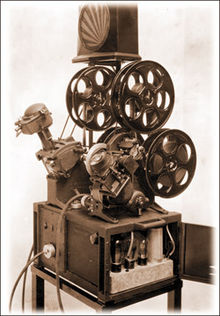- Moviola
-
- This is about the editing machine. For the television channel, see Movieola; for the British rural cinema service, see Moviola (cinema service).
A Moviola is a device that allows a film editor to view film while editing. It was the first machine for motion picture editing when it was invented by Iwan Serrurier in 1924.
Contents
History
Iwan Serrurier's original 1917 concept for the Moviola was as a home movie projector to be sold to the general public. The name was derived from the name “Victrola” since Serrurier thought his invention would do for home movie viewing what the Victrola did for home music listening (The Moviola even came in a beautiful wooden cabinet similar to the Victrolas). But since the machine cost $ 600 in 1920 (equivalent to $ 20,000 today), very few sold. An editor at Douglas Fairbanks Studios suggested that Iwan should adapt the device for use by film editors. Serrurier did this and the Moviola as an editing device was born in 1924.
Many studios quickly adopted the Moviola including Universal Studios, Warner Brothers, Charles Chaplin Studios, Buster Keaton Productions, Mary Pickford, Mack Sennett, and Metro-Goldwyn-Mayer. The advent of sound, 65mm and 70mm film, and the need for portable editing equipment during World War II greatly expanded the market for Moviola's products.[1]
Iwan Serrurier's son, Mark Serrurier, took over his father's company in 1946. In 1966, Mark sold Moviola Co. to Magnasync Corporation (a subsidiary of Craig Corporation) of North Hollywood for $3 million. Combining the names, the new name was Magnasync/Moviola Corp. President L. S. Wayman instantly ordered a tripling of production, and the new owners realized their investment in less than two years.
Wayman retired in 1981, and Moviola Co. was sold to J & R Film Co., Inc. in 1984. Moviola is still operating in Hollywood, California.[2]
Usage
The Moviola allowed editors to study individual shots in their cutting rooms, thus to determine more precisely where the best cut-point might be. The vertically-oriented Moviolas were the standard for film editing in the United States until the 1970s when horizontal flatbed editor systems became more common.
Nevertheless, a few very high-profile filmmakers continue to prefer the Moviola. Not least on this list is editor Michael Kahn famous for his work with Steven Spielberg. In fact, given the motion picture industry's accelerating trend toward digitization, Mr. Kahn may have given this classic piece of equipment its last hurrah in 2005 when Spielberg's Munich received an Academy Award nomination for Best Film Editing.
Awards
Mark Serrurier accepted a special Academy Award for Technical Achievement for himself and his father for the Moviola in 1979. There is a star on the Hollywood Walk of Fame for Mark Serrurier because of the Moviola's contribution to Motion Pictures.
See also
Notes
References
- Moviola.com – What is the Moviola story?
- city-net.com "INDUSTRY MOURNS ENTREPRENEUR MARK SERRURIER", by Denise Abbott
External links
Categories:- Film editing
- 1924 introductions
- Optical devices
Wikimedia Foundation. 2010.


